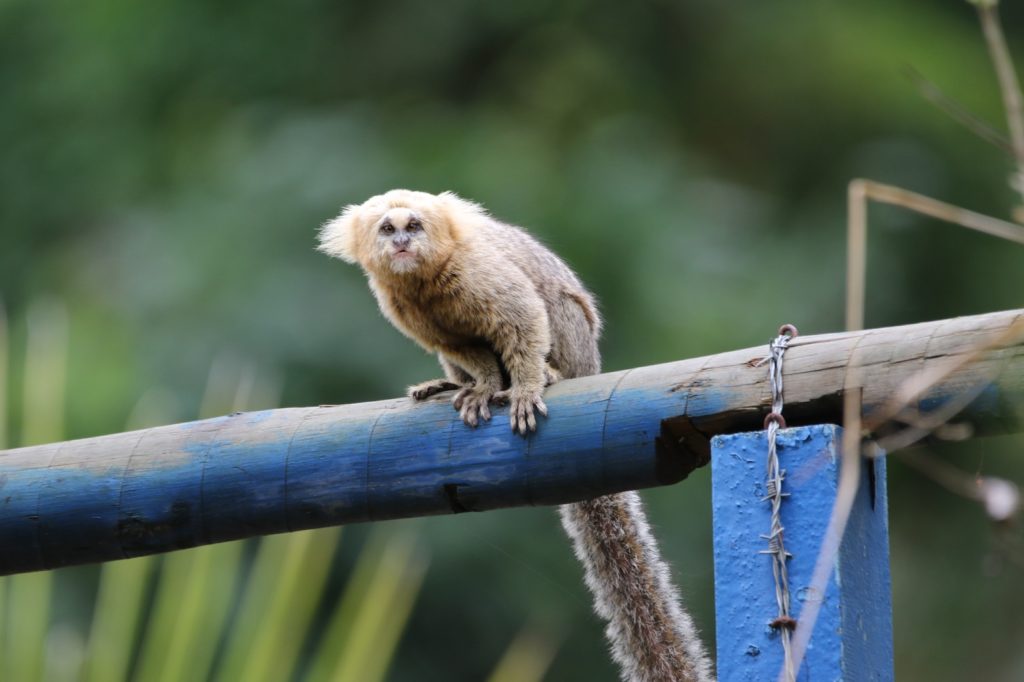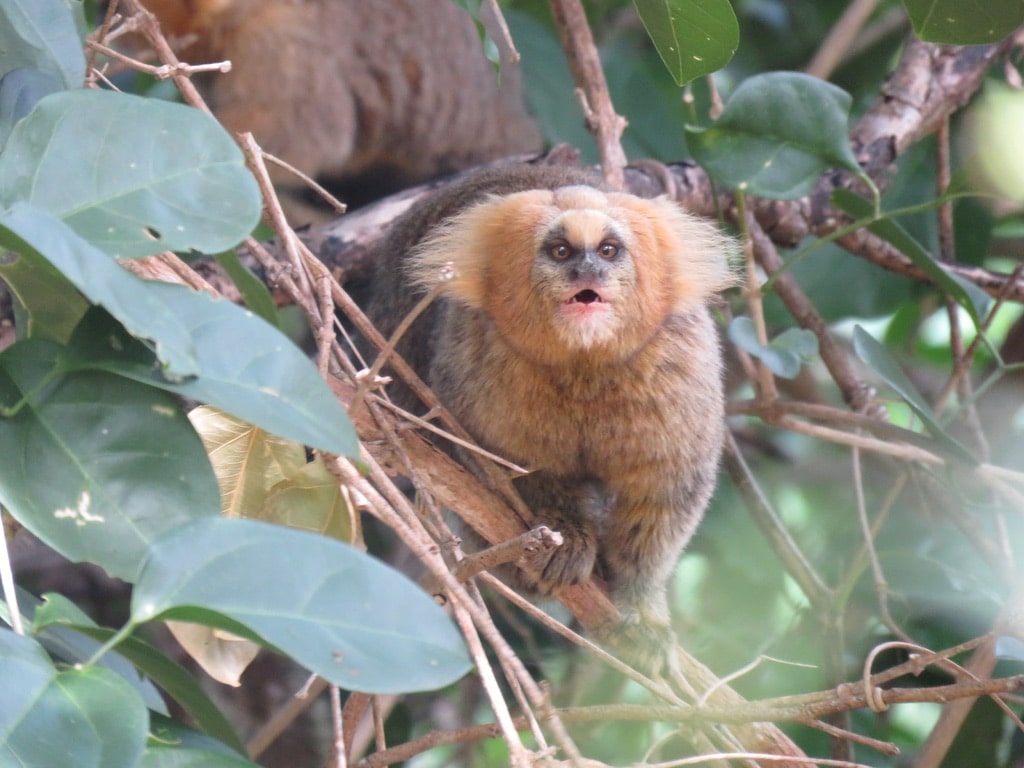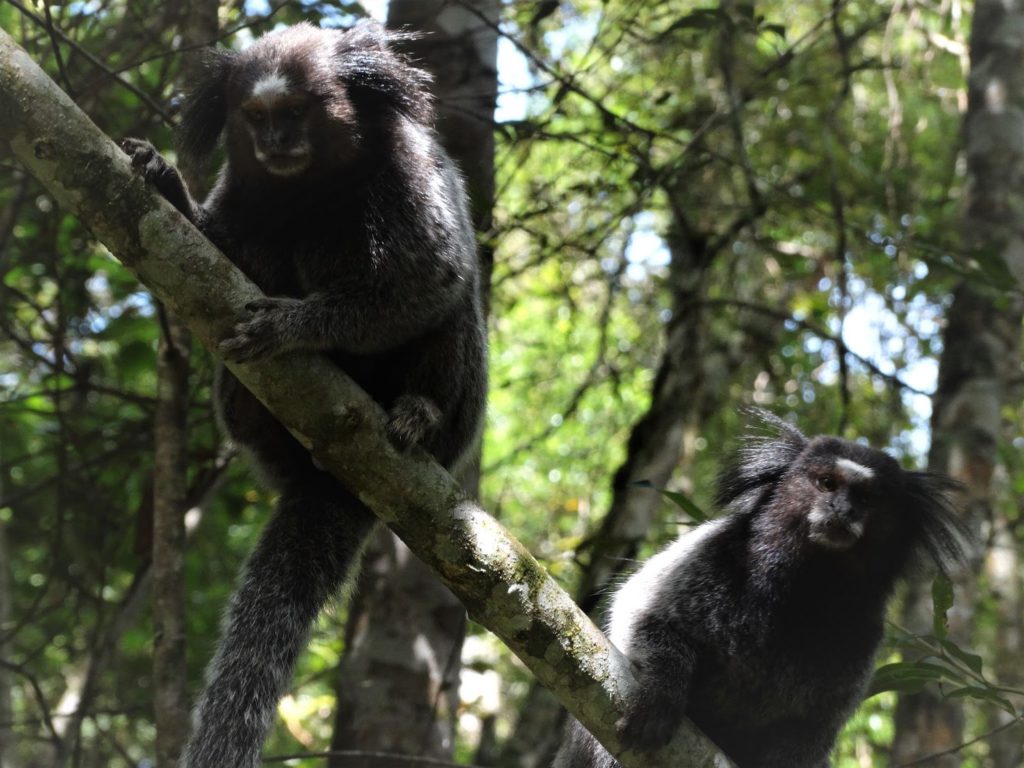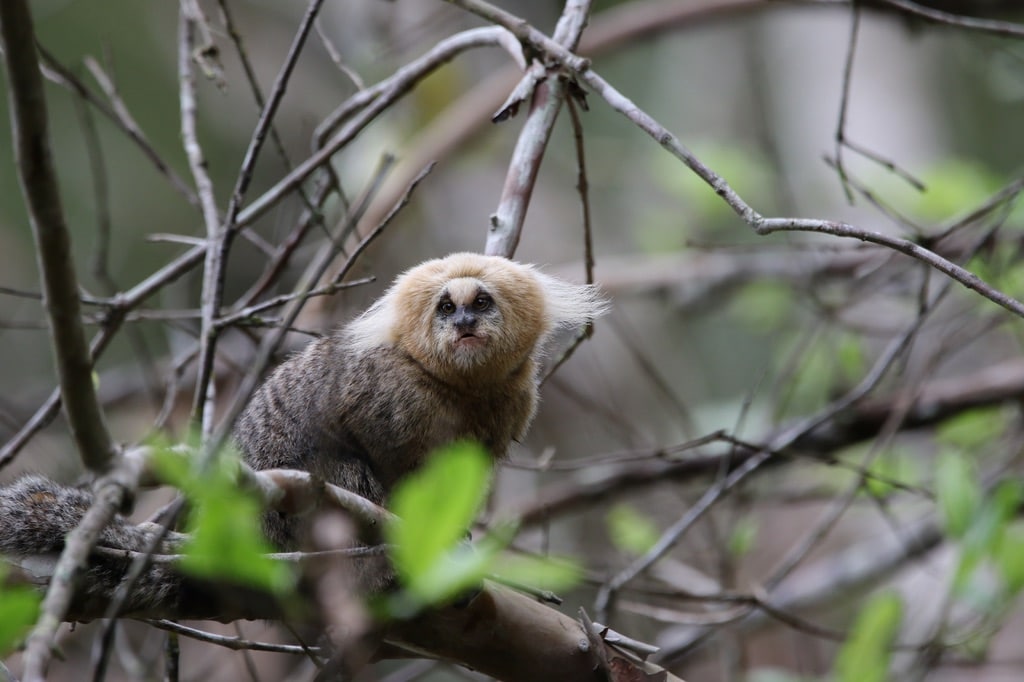The critically endangered buffy-headed marmoset is one of the rarest primates in the world. Suffering from a catastrophic decline and beset by countless threats, it faces imminent extinction in the wild. Non-profit Mountain Marmoset Conservation Program is battling to bring this charismatic species back from the brink of extinction.
—
Introducing the Buffy-Headed Mountain Marmoset
Despite its diminutive size, the buffy-headed marmoset (Callithrix flaviceps) is a charismatic-looking critter. With its melancholy expression, wacky ear-tufts, snub nose, and long claws, this miniature monkey would not look out of place among the loveable monster illustrations in Maurice Sendak’s famous children’s book Where the Wild Things Are.
The puny primate typically grows no larger than a squirrel and has a thick fur coat that helps it survive the cool temperatures of the mountain forests. The marmoset’s fur varies in colours from cinnamon brown to a yellowish-beige, the hue of a freshly poured mochaccino coffee.
The buffy-headed marmoset is endemic to the Atlantic rainforest biome of South-Eastern Brazil where it inhabits the higher-altitude montane forests that roll across the states of Minas Gerais, and Espirito Santo. This preference for montane habitats earns the species its colloquial name of ‟sagui-da-serra” or the ‟mountain marmoset” in Portuguese – a name it shares with its close relative the buffy-tufted marmoset (Callithrix aurita).
The marmoset is for the most part a mycophagist-insectivore – a term used to describe animals that have a diet of insects and fungi – though it also feeds seasonally on fruits and flowering plants. Occasionally this monkey has been observed to hunt and devour small lizards, snakes, tree frogs, and even birds.
It lives in groups made up of two to eight individuals but in the past when the species was more widely spread and in greater numbers, sightings of groups with up to 20 members were sometimes recorded. It displays complex social behaviour and though most groups seem to be led by a dominant monogamous breeding pair, there have been reports of polyandrous (one dominant female breeding with several males) and polygynous behaviour (one dominant male breeding with several females).

Male buffy-headed marmosets are model fathers and assist heavily in the care of infants by carrying them on their backs, which allows the mother time to rest and produce milk to feed her offspring. Juvenile marmosets generally stick with the family group until adulthood and help their parents with the care of newborn infants.
A diurnal species, the marmoset is active throughout the day, spending its time foraging for food, participating in social activities, and defending its territory from rival groups. At dusk, the troop will retreat to a communal tree hollow where they sleep out the night huddled together for warmth and safety from nocturnal predators.
Due to their small size, the buffy-headed marmoset makes for appetising prey for many predators. Hawks, owls, ocelots, boa-constrictors, pit vipers, and even toucans have been known to kill and eat marmosets. This heightened vulnerability to predation makes the marmoset a highly nervous species by nature and hyper-alert to any perceived dangers in its immediate surroundings.
The buffy-headed marmoset is an important species in contributing to the health of the Atlantic rainforest due to its diet of insects and fruit. Predation of insects by the monkey helps to regulate invertebrate populations while the consumption of fruit helps with the dispersal of seeds that eventually grow into trees – enhancing the structure, composition, and regeneration of the rainforest.

A Primate in Peril
The critically endangered buffy-headed marmoset is considered to be one of the rarest primates on the planet. According to latest estimates, no more than 2,500 individuals are left in the wild, a perilously low population. Bombarded by unrelenting pressures that continue to undermine its survival, the extinction of the species seems ever more probable in the 21st century.
Deforestation of its Atlantic rainforest habitat is the underlying driver of the decline of the buffy-headed marmoset. As much as 80% of this formerly colossal biome has vanished due to historical and contemporary logging and agricultural conversion. The little that remains of the rainforest in the states of Minas Gerais and Espirito Santo exists in a dismally diminished condition – mutilated and hemmed in on all sides by urbanisation and monoculture crops such as coffee, citrus fruits, eucalyptus, sugarcane, or cattle pasture. Monoculture farming also generates wider problems for the local environment due to the use of toxic pesticides and herbicides, groundwater pollution, soil erosion, desertification, and carbon emissions.
Fragmentation of rainforest isolates buffy-headed marmoset groups; they end up stranded in “islands” of habitat that are far too small and degraded to sustain them. Here, populations face long-term genetic dangers from inbreeding depression and more immediate anthropogenic perils such as forest fires which can spread easily from neighbouring farmlands and wipe out groups in a matter of hours.
Sylvatic yellow fever is an additional formidable threat to the continued survival of the marmoset. In recent years, several seasonal outbreaks have swept across South-Eastern Brazil, devastating primate populations and causing mass mortality. The buffy-headed marmoset has been one of the species most severely impacted by this disease with an estimated 90% decline across much of its range due to deaths during this period.
The spread of invasive species such as the black tufted marmoset (Callithrix pencillata) and the common marmoset (Callithrix jacchus) have complicated matters even further for the buffy-headed marmoset. These non-native marmosets first became established as invasive species in the South-East of Brazil due to the illegal pet trade. Trafficked from the Central and North-Eastern regions of the country to major cities such as Belo Horizonte and Vitoria, the wild-caught animals were then sold to the public as “pets”.

Before long, the non-native species had either escaped from captivity or were deliberately released to the wild where they flourished, thanks in no small part to urbanisation, which enabled their further dispersal and colonisation of rural areas. The ecological interlopers have now reached the last montane forest strongholds occupied by the buffy-headed marmoset where they outnumber, outcompete, and interbreed with the species, generating fertile hybrid offspring.
Hybridisation with the invaders accelerates the decline of the buffy-headed marmoset through a phenomenon known as “genetic swamping” – a process by which uncontrolled gene flow from interbreeding with a closely related common or invasive species puts an endangered species at impending risk of genetic extinction.
Safeguarding a Species
Due to the rapid decline of the mountain marmosets, the Mountain Marmoset Conservation Programme (MMCP) was founded in 2017 as a collaborative partnership mobilised to develop a plan of action for the conservation of these species.
The MMCP team comprises individuals from many different professions and walks of life including biologists, veterinarians, researchers, students, environmental educators, zoos, and other institutions all of whom are committed to working to safeguard the future of the critically endangered buffy-headed marmoset and the endangered buffy-tufted marmoset.
Current efforts by the conservation programme include the development of a national species action plan, researching the ecology of wild populations, mapping the distribution of the buffy-headed marmoset, studying and mitigating the spread of invasive species, and environmental education with local urban and rural communities.
A key future objective of the MMCP is to build the world’s first ex-situ (captive) population of the buffy-headed marmoset at the program’s official captive breeding center at the University of Vicosa – providing a crucial insurance population that will give the species a fighting chance to avoid extinction.
Discover more about the Mountain Marmoset Conservation Program’s work and how you can help support our efforts to save these endangered primates from extinction.
This story is written by James Hall, volunteer research coordinator at MMCP. Featured image by: Sarisha Trindade


















